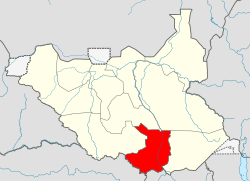Terekeka County
Terekeka County is an administrative division of Terekeka State in South Sudan.[1] The headquarters is the town of Terekeka, lying on the west bank of the White Nile 85 km (53 mi) north of Juba.[2] "Terekeka" means "the forgotten" in local dialect.[3]
Terekeka County | |
|---|---|
| Country | |
| State | Terekeka State |
| Population (2008) | |
| • Total | 140,396 |
| • Summer (DST) | +3GMT |
Location
Terekeka was carved out of Juba County in 2001. The main inhabitants of Terekeka county are the Mundari people.[2] In January 2009, Terekeka became the 25th Diocese of the Episcopal Church of the Sudan. The new diocese was headed by Rt. Rev. Micah L. Dawoudi, former Assistant Bishop of Juba Diocese.[4]
Economy
The county include low-lying swampy areas that are usually flooding but provide grazing in the dry season, and higher areas with less fertile, sandy soils. Rainfall is about 900 millimetres (35 in) annually. The people both cultivate crops and tend cattle. Cattle provide milk and represent wealth, but are neither sold nor slaughtered except in severe emergencies.[2] The people have suffered from cattle raids by the Dinka Bor of Jonglei State and the Dinka Alyap of Lakes (state) State. The government conducted a disarmament exercise in Terekeka county in 2009, leaving the Mundari people less well armed than the Dinka and less able to defend themselves.[3]
The people use various wild foods including green leaves, fruits and tubers, particularly during the April–May period when no other sources of food remain. Hunting for small wild game lasts from December into April. Fish are caught during the dry season (January to March) using locally manufactured spears, nets and hooks. The fish catch is normally high, and accounts for about 6% of total food.[2]
Infrastructure
As of 2005, just after the end of the Second Sudanese Civil War, most roads were poor and full of potholes and some could be used only in the dry season. Some roads were thought to contain land mines. Most of the people were considered very poor. [2] A 2010 report showed little economic improvement in the county. Literacy levels remain under 20%, roads are in poor shape, buildings are dilapidated and there is little security. There is minimal economic development apart from farming and herding. Goods "imported" from Juba are expensive, there are no banks and no radio stations.[3]
In 2010 6,000 children were enrolled in the 49 primary schools, which had just 52 teachers. The schools were in poor shape and extremely crowded, typically with 80 students in one room with no chairs or tables. There were two secondary schools with five teachers for 300 students.[3]
References
- Full list of Kiir's proposed new 28 states in S Sudan Archived 2016-03-05 at the Wayback Machine Radio Tamazuj
- "Terekeka County" (PDF). UN Sudan IG. September 2005. Retrieved 2011-08-03.
- "The forgotten land, Terekeka County in South Sudan". Bor Globe Network. September 2, 2010.
- Jonathan Mayen Nguen (April 26, 2009). "Terekeka Becomes a Diocese". Sudan Vision. Retrieved 2011-08-03.
External links
- "Mundari cattle camp, Terekeka". Retrieved 2011-08-03.
- "Water well, Terekeka county". Retrieved 2011-08-03.
- "Mundari man". Retrieved 2011-08-03.
